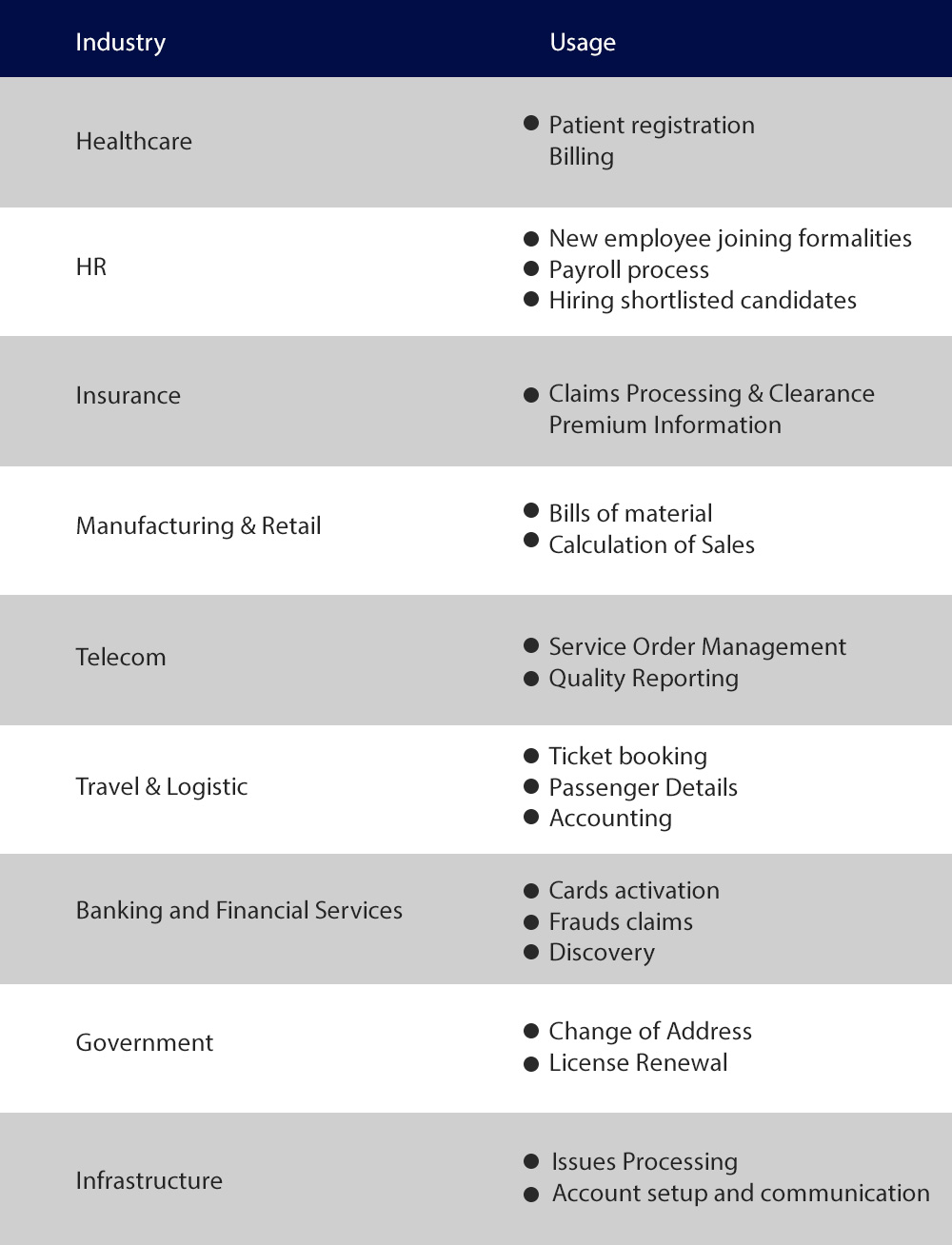Robotic Process Automation(RPA) has now become the buzzword in this tech world. RPA is yielding a lot of traction for its promise of enhancing business adaptability, making employees to work productively, and leading to an overall increase in profit.
What is RPA?
Robotic Process Automation is the software which enables to capture and integrate the actions of human communicating within digital systems to run a business processing like manipulating data, triggering responses and interact with other systems to accomplish on a wide variety of repetitive work.
For Instance, Imagine a human is sitting in front of a computer looking at the applications and performing the work. While Robotic Process Automation does not involve any form of physical robots, it’s a software that performs human activities by interacting with the applications in the same way that a person does. It is like working as a virtual assistant, and the bot will complete the tedious tasks, free up time for employees to concentrate more on entertaining, and revenue-generating tasks for an organization.
Why RPA?
With any change in the business process, an organization needs to hire a new employee or train the existing employees to map IT system and business process on those repetitive tasks. Both solutions are time and money consuming. With RPA, the organization can deploy virtual workers who mimic human workers for repetitive tasks. In case of a change in process, software code change is always faster and cheaper than retaining hundreds of employees for the repetitive tasks to be done.
How do RPA works?
Robotic Process Automation (RPA) will work with your existing applications and carry out structured processes automatically. RPA does the task just like employees do it. And can automate various variety of operations that include invoice processing, report generation, and employee onboarding very effectively, quickly with errors and fully automatically.

Activities that RPA can take out:
- Process Attachments and emails
- Extract and change data, create reports, calculations
- Filling forms
- Run if/then commands
- Process data from the internet
- Extract and change data, create reports
- Read and process information from multiple systems
- Access social media
- Move, copy, and paste data.
- Login and operate systems
- Automated report generation
- Information validation and auditing
- Product management
- Quality Assurance
- Data migration
- Gas Solutions
- Productive management
- Read and write to the database
- Technical Debt management
- Quality Assurance
- Perform multiple tasks
- Revenue forecasting
Let’s check how works can be automated with RPA in the below image:

Benefits of having RPA in the Organization
RPA is being adopted and implemented in businesses, where human and technology work together in harmony, allows better insight into trends and opportunities for businesses. Still, some few people are thinking about whether RPA is worth to invest. If you are between those who are not 100% certain, let’s have a look at some of the benefits of RPA that can be provided to your organization.
- Cost Saving: Automating tasks will save the major of the organization productive time and cost.
- Better Management capabilities: Management operations will be done in a better way from centralized management platform with high security using remote server controls.
- Enhance Customer Experience: RPA relieves employees from repetitive tasks which are in high volume that includes purchase order issues and claim to process with better quality services to the clients.
- Accurate Quality work: RPA will work most effectively and perform error freely, which eventually results in better quality with higher satisfaction rates with profits.
- Simplicity and Flexibility: RPA will deliver quick returns to the organization with automated tasks and workflow.
Types of RPA
There are three types of RPA:
- Attended Automation: Human intervention while performing automation process.
- Unattended Automation: These types are intelligent and are capable of decision-making — no need for human involvement.
- Hybrid RPA: It is the combination of both attended and unattended RPA tools.
Test Automation Vs RPA

Industries using RPA
Here is the list of industries using RPA:
- Manufacturing: For the manufacturing industry, RPA helps in handles many repetitive tasks like product packing, operational processes. Some other tasks handled by RPA are
- supply chain management
- Administration
- Reporting
- billing of material
- customer service
- data migration.
- Banking: Banking industries handle a massive number of account documents, templates, deposits, and many other transactional files. The banking industry sector is trying to identify a way to effectively and securely manage the day to day process. With the introduction of RPA software, everything was streamlined for ease of access. Some of the activities that RPA handles are listed here:
- Data security
- withdrawals
- Deposits
- Customer assistance
- Secure transaction handling
- Healthcare: Healthcare sectors handle routine administration tasks. Using RPA, many of the repetitive work will be done naturally. Some of the tasks are
- Patient scheduling
- Claims processing
- Patient’s data entry
- Billing
- Insurance: Insurance companies deal with providers of car, health, travel, property. They have much to handle claims processing, quotes, and underwriting, which is in high volumes of repetitive tasks. By using RPA, everything will be managed in an easily. Some of the tasks handled by RPA are:
- Customers data entry
- Filling forms
- Handling legacy applications
- Compliance maintenance
- Quotes
- Claim processing
- Retail: Retail industry generally handles customers directly, which is a routine and repetitive task which involves many difficulties. Using RPA, it supports in orders updating, billing, etc. some of the activities RPA handles are
- Product shipping
- Tracking shipment
- Refunding amount
- Sending push notification
- Telecommunication: People get frustrated when trying to connect to the never-ending phone. But it got directed to a bot who never answer the call or answer the query. RPA helped in managing fraud data, updating, answering customer queries, and monitoring customer data. Some of the services that RPA handles are:
- Managing fraud data
- Updating data
- Answering customer queries
- Tracking customer data
Here in the below image, you can find more industries in which RPA can work effectively

Top RPA tools
Here is the list of top robotic Automation Tools:
- Inflectra Rapise: Small and medium organizations are the perfect fit for using Rapise. It provides an on-promise solution that is friendly for both programmers and non-developers. It includes support for hybrid business scenarios and can automate web, desktop, and mobile applications.
- Best Features:
- Project Automation of any size
- It can support having the functionality of recording and play
- Automation of web and desktop screen scraping
- It can help calls on REST and SOAP, any email processing such as Gmail, Office 365, Private mail servers, etc.
- It provides excellent support for an open platform for improvements and integration.
- It provides excellent assistance for Microsoft Dynamics applications.
- Advantages
- Non-developer friendly
- It could provide back up with training and certifications
- It can execute anything very quickly and accurately.
- Disadvantages
- It works only in Windows
- Best Features:
- Blue Prism: This tool is used for medium and large organizations that connect enterprise technologies like AI and MI. It will work on any application. To use this tool, one must have programming skills.
- Best Features:
- It can work for any platform and application
- It provides high security for software and network credentials
- Advantages:
- It never dependent on the platform
- The execution will be done quickly
- Disadvantages:
- The price will be very high
- Must have programming skills
- Best Features:
- Automation Anywhere: It will provide services on all core capabilities. It creates smart bots that perform tasks in different areas of the business. This tool offers on-premise and cloud services, which are perfect for medium and large scale organizations. It is deployed in the front-end for the rules-based processes as well as in the back-end for an accurate and complete RPA solution. Even it has a feature of analytics and reporting with intelligence about the performance of their bots and their impact on the business.
- Best Features:
- It provides high Bank-grade security through authentication, encryption, and credentials.
- It has real-time reports and analytics
- It offers platform independence
- Advantages
- User-friendly
- Disadvantages
- Need enhancement in IQBot
- Best Features:
- UIPath: It provides services on all core competencies. It gives full support for Citrix and is user-friendly for non-developers. It is capable of handling complex processes and is the best fit for all sized business.
- Best Features
- It provides high-end security and encryption for managing credentials and access control based on the role.
- It provides eight to ten times faster automation process using Citrix.
- It offers an open platform and can handle any process, bulk in number, irrespective of its complexity.
- Advantages
- Free of cost with useful features
- Non-programmers can handle it easily
- Uses drag and drop for secure handling.
- Disadvantages
- Coding functionality is limited
- Best Features
- Pega: It is a business process management tool which is used on desktop servers. It offers services on cloud-based solutions that can work on Windows, Linux, and Mac. This is the best fit for large and medium-sized businesses.
- Best Features:
- It provides a cloud-based solution
- It never stores any execution data in the database; rather, everything will be stored in memory.
- Using this, you share the work to the server, desktop, and even employees.
- Advantages
- It works faster due to the event-driven approach
- It is the most reliable and robust tool.
- Disadvantages
- No on-premise solution
- Best Features:
- Nice Systems: Nice System is well-known as NEVA-Nice Employee Virtual Attendant, which is used to handle employees in repetitive tasks.
- Best Features
- It provides automation for an attended and unattended server.
- It is best used for employees from the back office, finance, and HR activities
- It will help in automating mundane tasks, compliance adherence, and also in up-sell.
- It offers cloud-based and on-premise solutions.
- Advantages
- It offers advanced analytics
- Best Features
Besides this, some other additional RPA tools are listed below:
- Contextor: This tool provides on-premise and cloud services with support for Citrix and RDP hybrid virtualization environment. It is the best to fit for the front office of any size and works for all workstation applications in parallel. It can communicate with active and minimized applications. It has a real-time report and analytics report.
- Kofax: Virtually works with any application. It works on repetitive tasks efficiently. No coding skills required for this tool. It can process data from any website, desktop app, and portal. It can be easily integrated with Kapow Katalyst platform. It can be managed centrally from a server.
- Kryon: It has three types of solutions, namely unattended, attended, and hybrid, which helps in improving productivity with recording facility.
- Softmotive: It provides two solutions that are enterprise automation and desktop automation. Enterprise automation helps in increasing the productivity, performance, and efficiency of enterprises. Desktop automation is best fit for individuals and small teams. This tool will help in the design process to the production process with accuracy, high security, and error handling. It can be easily integrated with SAP, Salesforce, oracle financials, and Peoplesoft automation, etc. .Net and SQL server support it.
- Visual Cron: It is used for task scheduling and integration. No programming skills are required. Works only under Windows. Based on technology, the tasks can be customized. Using API programming can do. It has a user-friendly interface. It doesn’t require any programming skills.
- Antworks: Antworks RPA is also known as ANTstein. It supports a code-free environment and can work with any data. Without programming and designing processes BOT development will be done with the help of Antworks.
- Redwood Software: It supports automating repetitive works, which is easy to use and scalable.
- Jacada: The primary purpose of Jacada RPA is to support interaction, contact centers, and customer services. It helps to enhance accuracy, customer satisfaction, and productivity.
- Work Fusion: SPA is used for automating data related tasks which work under AI-driven RPA.
Conclusion
RAP has now become the trending technology and most of the industries are looking for automation of their repetitive works. Using RPA their will be a lot of cost-saving and also there will be an effective use of resources. RPA is the best methodology for making tasks automation. RPA involves intelligent automation ethos that must be part of the long-term journey for enterprises to complete business processes faster, with better quality and at scale.
Krify is the leading mobile and website development company in India and UK which is one among the RPA service provider that makes automation for repetitive tasks to save their time and money. Contact us for more details.








